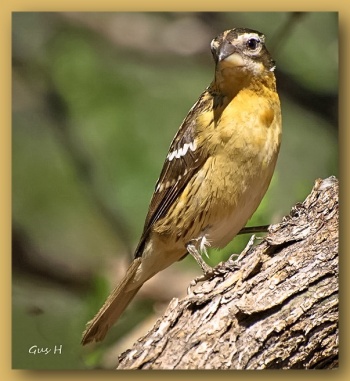- Pheucticus melanocephalus
Identification
18-19 cm (7.1-7.5 in)
Male
- Black head, wings and tail with prominent white patches
- Dark to tawny orange breast
- Yellow belly
Female
- Brown head, neck and back with black streaks
- White streaks down the middle of the head, over the eyes and on the cheeks
- White breast
- Greyish brown wings and tail, with two white wing bars and yellowish wing edges.
Distribution
North and Central America
North America:
Canada: Alberta, British Columbia, Saskatchewan
United States of America: Western states including Arizona, California, Colorado, Idaho, Kansas, Minnesota, Missouri, Montana, North Dakota, Nebraska, New Mexico, Nevada, Oregon, South Dakota, Texas, Utah, Washington, Wyoming. Vagrant to Eastern states.
Central America: Mexico, Baja California
Taxonomy
Subspecies
There are 2 subspecies[1]:
- P. m. maculatus:
- Mountains of south-western British Columbia to northern Baja California
- P. m. melanocephalus:
- South-eastern British Columbia to Rocky Mountains, Great Plains and southern Mexican Plateau
Habitat
Deciduous and mixed wooded areas with large trees, thick bushes, streamside corridors, river bottoms, lakeshores, wetlands, and suburban areas.
Behaviour
Diet
The diet includes pine and other seeds, berries and insects, spiders and fruit.
Breeding
The female builds the saucer-shaped nest 3-35' up in a broad-leaved tree or shrub. It is constructed from grass, twigs, bark, conifer needles, etc and lined with hair and other fine material.
The clutch which consists of 2-5 pale green, blue or grey eggs (with red or dark brown spots) is incubated by both sexes for 12-14 days. Fledging is around 11-12 days, but flight takes a further 2 weeks. Both adults feed the young.
References
- Clements, J. F., T. S. Schulenberg, M. J. Iliff, S. M. Billerman, T. A. Fredericks, B. L. Sullivan, and C. L. Wood. 2019. The eBird/Clements Checklist of Birds of the World: v2019. Downloaded from http://www.birds.cornell.edu/clementschecklist/download/
- Lepage D. (2020) Black-headed_Grosbeak in Avibase - The World Bird Database. Retrieved 21May 2020
- Wikipedia contributors. (2019, December 28). Black-headed grosbeak. In Wikipedia, The Free Encyclopedia. Retrieved 07:35, May 21, 2020, from https://en.wikipedia.org/w/index.php?title=Black-headed_grosbeak&oldid=932824838
- Ortega, C. and G. E. Hill (2020). Black-headed Grosbeak (Pheucticus melanocephalus), version 1.0. In Birds of the World (A. F. Poole, Editor). Cornell Lab of Ornithology, Ithaca, NY, USA. https://doi.org/10.2173/bow.bkhgro.01
- Cornell Lab of Ornithology. 2019. Black-headed_Grosbeak in: All About Birds. Cornell Lab of Ornithology, Ithaca, New York. https://www.allaboutbirds.org/ Accessed on 21May 2020.
Recommended Citation
- BirdForum Opus contributors. (2025) Black-headed Grosbeak. In: BirdForum, the forum for wild birds and birding. Retrieved 12 May 2025 from https://www.birdforum.net/opus/Black-headed_Grosbeak
External Links
GSearch checked for 2020 platform.1






